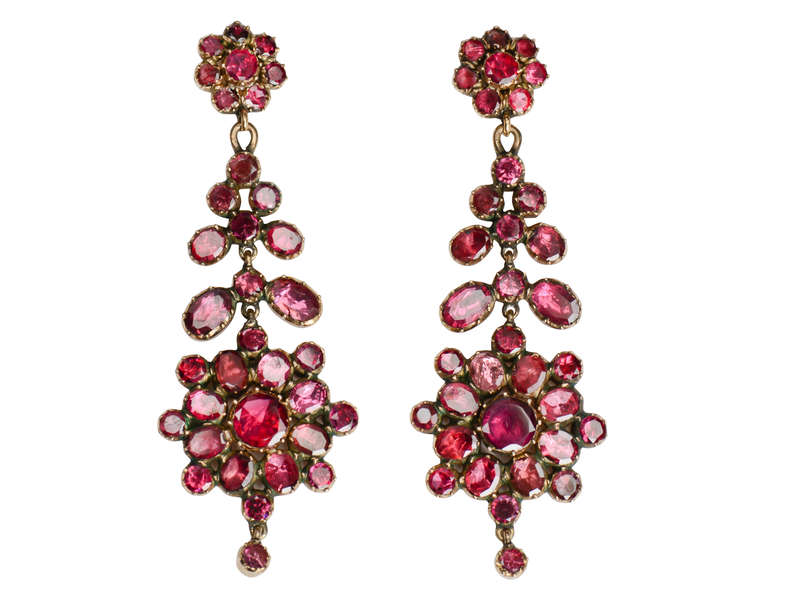
Pinnacle - Almandine Georgian Garnet Earrings
Rule number one of jewelry identification is to look at the back or reverse first. You will note that in these exceptional Georgian earrings, all of the stones are set into closed metal. Only the tops of the gemstones show.
Additionally, the treatment for the back is flat and the profile is thin. Earlier earrings and jewelry often utilized bulbous, sculptural, and rounded metal to the reverse. But this transitioned during these decades to a more neoclassical outlook.
Length is another key. At this time, European women's costumes and dress were often draped low across the chest (sometimes covered by diaphanous scarves termed fichus), and the hair was upswept.
This was the perfect backdrop for elongated, dangling earrings to highlight the neck and face.
Rhodolite and almandine garnets were favored gemstones; perhaps you have seen them used in pansy motif jewelry. Rose gold (9K) was another often employed precious metal.
Superb overall, these earrings are set with flat-cut purple-hued garnets, ranging in shades from claret red, to light peony pink. Formerly day-night in configuration, that would have back-to-front ear wires, some time ago they were converted to a single earring with post fittings.
The foiling beneath the garnets takes these to magical heights. Circa 1810 and over 200 years old, fine and rare.
Provenance: From a private Texas collection purchased from The Three Graces in 2004.
FREE WORLDWIDE!
Lightning Fast
Most purchases ship the same day if purchased by noon Eastern.
Shipping occurs M-F and arrives M-Fri or Sat by USPS.
Shipments are anonymous for surprises and gift-giving.
DOMESTIC METHODS



FREE 2 DAY via UPS or FedEx. Also 2-4 DAY USPS (under $500).
- A physical address and phone number are required.
- IMPORTANT: A signature is required for insurance
- If missed, redelivery occurs the following day.
HOLD OPTIONS
Hold at FedEx hold locations or UPS Stores. A photo ID of the addressee is required.
USPS hold at your local post office.
UPGRADED OPTIONS CHARGES
2 Day morning delivery. Usually by 10:30 am. $35—to major areas
Overnight—$35
Priority Overnight Usually by 10:30 am—$45
Saturday Delivery—$50
INSURANCE
GRATIS! Every package is fully insured by a specialized jewelry insurance carrier. You receive a full refund right away if lost, damaged, or stolen. Contact us immediately! Remember, after shipping thousands of packages a year since 2002, problems are very rare.
HOW IS MY JEWELRY BOXED?
A lovely hand-made Italian gift box with a fabric ribbon is provided. Please refer to this page for photographs and more information.
FREE RETURN SHIPPING
If for any reason you are not happy with your purchase, even returns are free from anywhere within the US. Visit the Returns section for details. Our apologies, but due to customs forms and regulations, international buyers pay for return shipping.
INTERNATIONAL SHIPPING


Express service fee is $75, fully insured via UPS or FedEx, 2-7 day service.*
Contact us to receive an estimate for any taxes, duties, or fees.
*Custom's clearance times vary.
FREE WORLDWIDE!
Lightning Fast
Most purchases ship the same day if purchased by noon Eastern.
Shipping occurs M-F and arrives M-Fri or Sat by USPS.
Shipments are anonymous for surprises and gift-giving.
DOMESTIC METHODS



FREE 2 DAY via UPS or FedEx. Also 2-4 DAY USPS (under $500).
- A physical address and phone number are required.
- IMPORTANT: A signature is required for insurance
- If missed, redelivery occurs the following day.
HOLD OPTIONS
Hold at FedEx hold locations or UPS Stores. A photo ID of the addressee is required.
USPS hold at your local post office.
UPGRADED OPTIONS CHARGES
2 Day morning delivery. Usually by 10:30 am. $35—to major areas
Overnight—$35
Priority Overnight Usually by 10:30 am—$45
Saturday Delivery—$50
INSURANCE
GRATIS! Every package is fully insured by a specialized jewelry insurance carrier. You receive a full refund right away if lost, damaged, or stolen. Contact us immediately! Remember, after shipping thousands of packages a year since 2002, problems are very rare.
HOW IS MY JEWELRY BOXED?
A lovely hand-made Italian gift box with a fabric ribbon is provided. Please refer to this page for photographs and more information.
FREE RETURN SHIPPING
If for any reason you are not happy with your purchase, even returns are free from anywhere within the US. Visit the Returns section for details. Our apologies, but due to customs forms and regulations, international buyers pay for return shipping.
INTERNATIONAL SHIPPING


Express service fee is $75, fully insured via UPS or FedEx, 2-7 day service.*
Contact us to receive an estimate for any taxes, duties, or fees.
*Custom's clearance times vary.
 Authenticity Guaranteed
Authenticity Guaranteed
 Fast Shipping
Fast Shipping
 No Question Returns
No Question Returns

Breathtaking Engagement Rings
As distinctive as you are, every engagement and wedding ring is unique and handpicked for its aesthetics, condition, and authenticity. Filigree work, cluster or halo rings, three stones, wedding sets, diamonds or fine gemstones - you will know it when you see it.
Experience The World of The Three Graces
Trust & Honesty
Testimonials
The Three Graces adds a personal touch with absolute professionalism that makes every interaction special.
I have been buying here more than a decade. An ever-changing collection that feels curated, carefully chosen, always high quality.
It never ceases to amaze me how every lovely piece of antique jewelry is so immaculate and ageless.












